Today is the 13th Anniversary or the death of Terry Nation
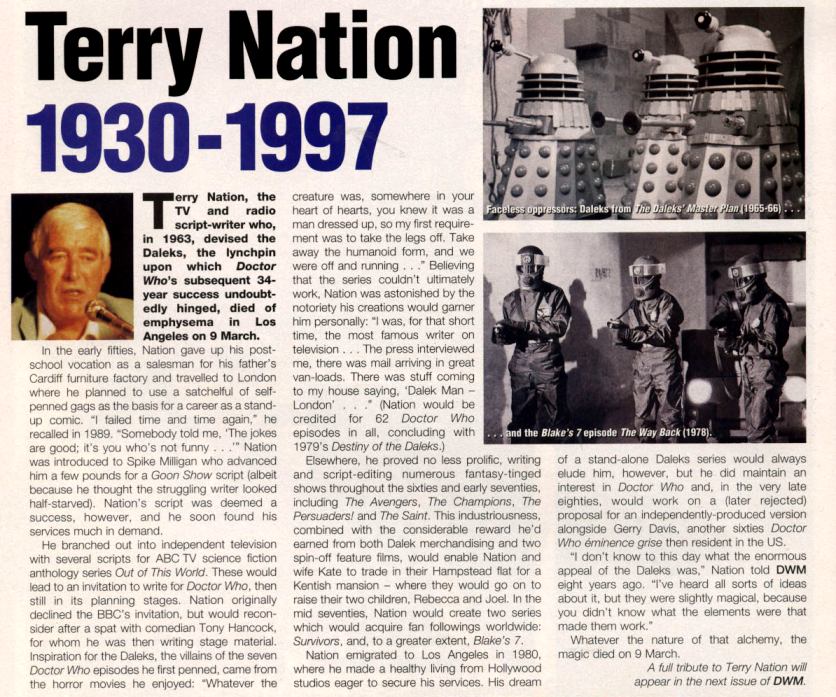
Today is the 13th Anniversary or the death of Terry Nation





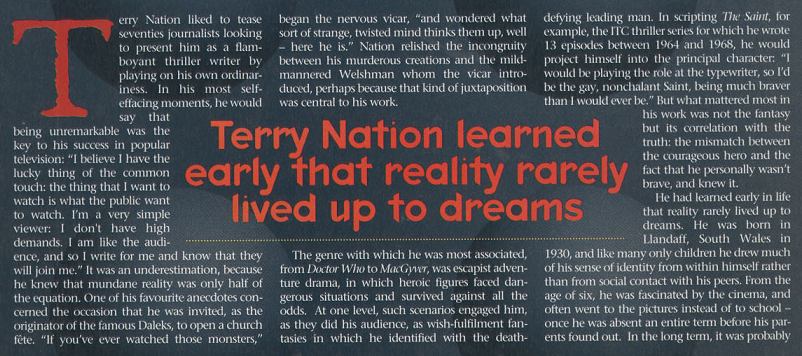


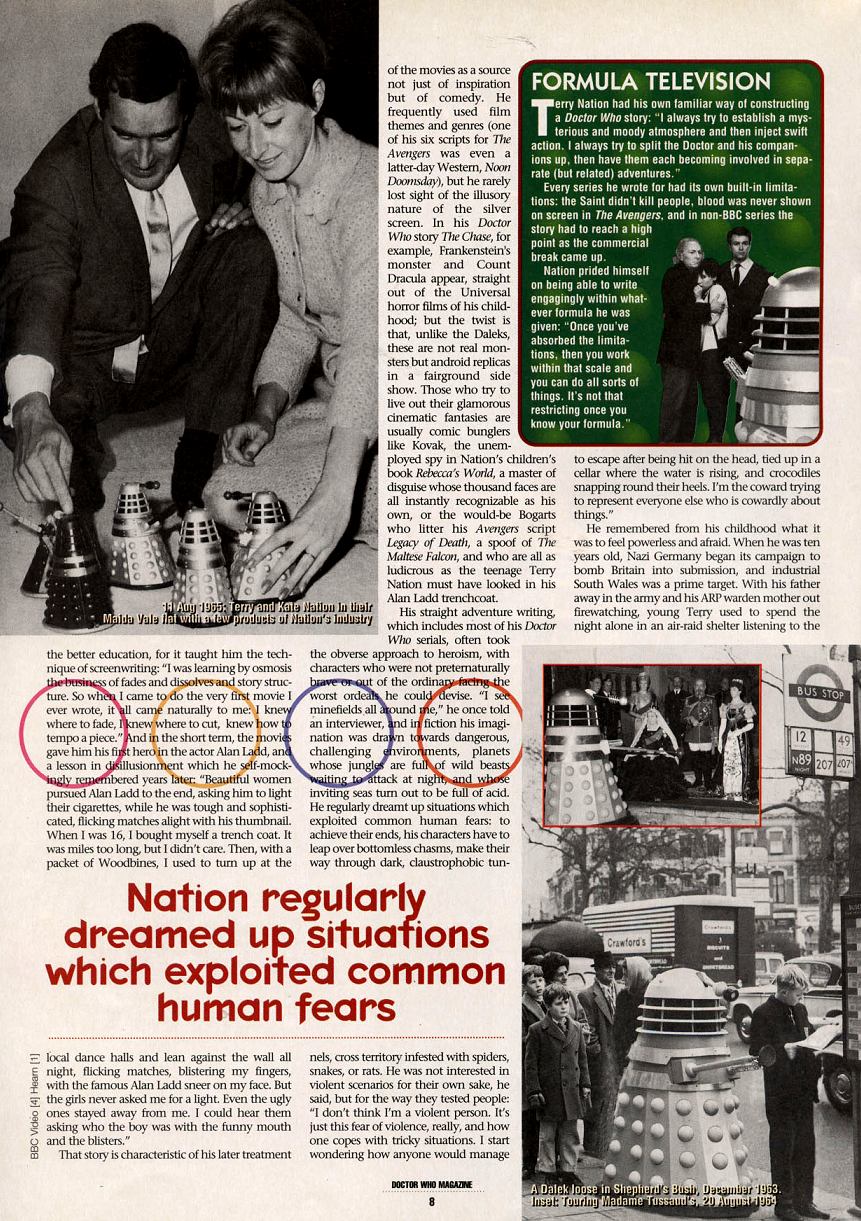












The Varga plants (sometimes spelt Vaarga) originally appeared in the First Doctor episode Mission to the Unknown the single-episode prologue to the serial The Daleks’ Master Plan.
The Vaaga plants, like the Daleks, were created by Terry Nation.
Varga Plants grew naturally on the Daleks’ homeworld, Skaro. The Daleks experimented upon them creating further mutations. By the 39th century, the Daleks had imported them to other worlds. (Mission to the Unknown)
When the Daleks set up a base on the planet Kembel they brought some Varga plants with them to act as sentries in the jungle surrounding their base. They were suited to this as they could move around freely by dragging themselves along with their roots.
Varga plants resembled cacti; they are covered in fur and thorns. Anyone pricked by a Varga thorn will be consumed by the urge to kill, while simultaneously becoming gradually transformed into a Varga plant themselves. An infected victim would first become homicidal. As the infection progressed, white hair would grow over their bodies. This grisly fate befell astronauts Jeff Garvey and Gordon Lowery, and their commander, Marc Cory, was forced to kill them.
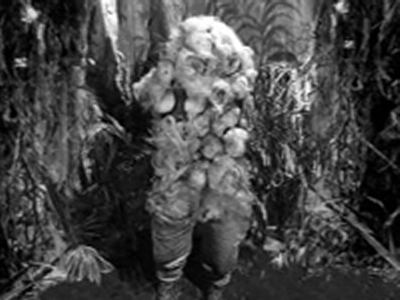
The plants later made an appearance in the Big Finish audio I, Davros: Purity. In this, it was revealed that the Varga plants were one of the oldest species on Skaro, but for most of their history had been immobile. Since the start of the Kaled-Thal war however, exposure to radiation and chemical weapons had caused them to rapidly evolve into a much deadlier form, capable of self-locomotion. It was this discovery that caused Davros to become interested in genetically engineering creatures in order to create weapons of war. Varga plants existed from an early point in Skaro’s history. The name “Varga” meant “devourer” in the Dal language. Originally they could not move; instead they would wait until their prey approached them. Later, due to the chemical and radiological pollutants in Skaro’s atmosphere and environment, they began to mutate and became able to move. (I, Davros : Purity)
The plant was again found on a terraformed Jupiter where the plant infected a large battalion of Earth Alliance troops. (Dalek Empire II: Dalek War)
Varga Plants appeared in City of the Daleks where after the Time War they infested the ruined Dalek city of Kaalann on Skaro but here their appearance was rather different.

The Varga plants that infested Kaalann were different in appearance, being more akin to a Venus Flytrap and immobile. Their venom also killed with a touch.

So will the Varga / Vaaga plants ever appear again in Doctor Who? Probably not, but you never know…

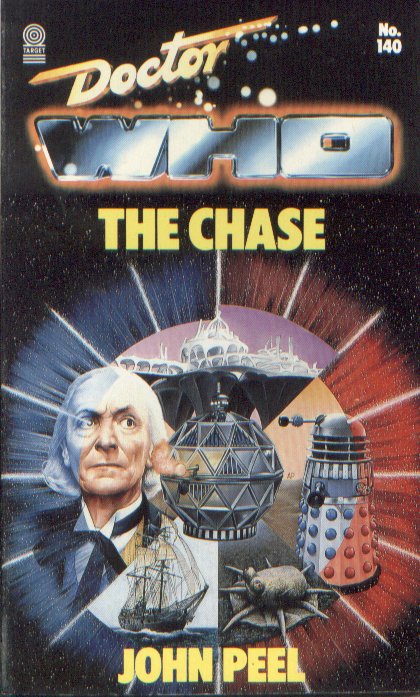
From the back cover of the novelisation of “The Chase” by John Peel :
1989 Edition
Through a Space-Time Visualiser the Doctor and his companions are horrified to see an execution squad of Daleks about to leave Skaro on a mission to find the TARDIS and exterminate the time travellers. Eluding the Daleks on the barren planet Aridius the Doctor and his friends escape in the TARDIS. But this is only the beginning of an epic journey. As they travel through space and time, they try to shake off their pursuers by making a series of random landings—but the Daleks don’t give up easily. This is a chase to the death…
1991 edition
“Those who control the TARDIS have interfered with too many of our plans. They are to be destroyed. If necessary, the assassination group will pursue them through all eternity. Exterminate them!”
The Doctor, Barbara and Ian had faced – and narrowly defeated – the Daleks twice before. They had known that there was always the possibility that the Daleks would win. But the reaches of time and space had always seemed so safe – there was always the chance that if they were being overwhelmed, they could flee.
But now, the Daleks can track them through all of time and space. They try to shake off their attackers by making a series of random landings, but this is a chase to the death …
Doctor Who – The Chase, written by Terry Nation, the creator of the Daleks, was first broadcast in 1965, with William Hartnell playing the role of the Doctor. This adaptation is by John Peel, who is also the author of The Gallifrey Chronicles, the definitive history of the Doctor’s home planet and its people.
You can read the novelisation of The Chase here
In these days of hard drive recorders, DVD releases of TV series appearing rapidly after airing, repeats on multiple channels in standard and HD broadcasts, the BBC’s iPlayer service, youtube – and so on – it is sometimes easy to forget just how little information on past television stories was available to Doctor Who fans back in the 60s, 70s and early 80s.
Quite apart from the BBC junking many of the black and white episodes (and in the process probably loosing themselves millions of pounds of future revenue), the Doctor Who shows that did exist remained locked in an archive, seemingly never to be repeated on TV and thus totally inaccessible to millions of fans. Back before even video cassettes were available, all a Doctor Who fan had in the way of past stories was the range of novelisations produced by Target books. And frankly, speaking as someone who grew up reading them, they were pretty damned good at the time.
While several of the Dalek stories were novelised by Target authors, disputes between the BBC, Target and Terry Nation (and after his death, the executors of his estate) delayed further novelisations of Dalek stories for many years. Target had been trying to acquire the rights to adapt The Chase, along with the epic The Daleks’ Master Plan and the two Second Doctor Dalek stories, The Power of the Daleks and The Evil of the Daleks. For a time it seemed as if these stories (of which only The Chase still existed in complete form in the BBC Archives) would remain unnovelised along with the three Fourth Doctor stories by Douglas Adams and the two Eric Saward Daleks stories from the Fifth and Sixth Doctor eras. A surprise resolution regarding the rights to the early Dalek tales opened the door for Target to novelise them, and John Peel was assigned the task of adapting these stories. The Chase was chosen to be the first of these books published, as it was the first to be broadcast.
John Peel said of his novelisation –
When Target stopped publishing and the Dr Who franchise was picked up by Virgin books, there was a bit of a trend to dismiss the Target novels as being rather weak and childish, presenting Doctor Who in a “comfortable” format and shying away from the more “adult” issues which the Virgin series was keen to embrace (probably rather too whole heartedly in my opinion). Some such criticisms may be justified, at least in part. On the whole the prose style of most of the Target range was fairly undemanding and wouldn’t stretch the reading ability of a literate child let alone a well read adult. But in fairness, they were published primarily as children’s books, appealing to adult fans only as a secondary concern but, like the TV show, still perfectly accessible to adults. As such, they did a really excellent job of inspiring a generation or two of Doctor Who fans many of which encountered past Doctors for the first time through the pages of the novels, growing to love bygone eras of the show in the process.
The Target books have been out of print for many years now, though such was their popularity that they can still be found fairly easily second-hand. The BBC have started producing some of the Target novels as audio books but it is anyone’s guess whether they will ever release the entire range. Probably not. In many cases it is simpler to produce an audio recording from the original story with linking narration – as they have done on many occasions. While understandable, this is sometimes rather a shame, as the Target novels have a certain something of their own.
One of the criticisms often levelled at book adaptations is that sometimes they don’t stick to the story exactly as it was televised. Often this criticism is made by the same people who criticise the uninventive prose style of novelisations that simply take the original script and add in some description (come on guys, you can’t have it both ways). Certainly some of the Target range of stories included characters, scenes and other changes that were not as-seen-on-TV. For the most part, I don’t have a problem with this. Often in makes for a better novel. Doctor Who in the 60s and 70s operated on a shoe-string budget, had to use endless deserted quarries as alien planets, had tight recording schedules (etc) and therefore couldn’t always display the kinds of scenes and scenery on TV that an author can furnish in a book. In addition, Doctor Who on TV doesn’t for the most part lend itself to detailed asides concerning a character’s background or thought processes – all of which are far easier to convey in a text. The Target novelisations may not always have stuck exactly to the stories as shown on TV, but they extended the stories in many ways, often for the better.
In addition to the personal whims of an author, another aspect to the novelisation process was that it sometimes allowed the (re)inclusion of material originally planned for a TV show but for one reason or another cut from the televised story. John Peel’s novelisation of “The Chase” is a case in point. The author writes in his forward :
“This book is not strictly an adaptation of the televised
version of The Chase. It follows, for the most part, the original
scripts for the show, as written by Terry Nation. As is the case
with most series, the original scripts were rewritten for various
reasons—to make scenes less expensive, to perform the
actions in a simpler way, or to add character touches to the
story. In the case of The Chase, the changes made from Terry’s
original scripts were sometimes quite extensive.
Faced with the task of novelizing either Terry’s scripts or
the televised ones (presumably the changes having been made
by then-story editor Dennis Spooner), I have in most cases
opted to stay with Terry’s versions. There are two main
reasons for this. Firstly, the original scripts delve more deeply
into the alienness of the creatures that the Doctor and his
companions meet. On the television, a lot of this was cut
simply because it would have been too expensive to film. In a
book, I am under no such constraints. Secondly, the television
version of The Chase exists in its entirety, and may some day be
seen again by British audiences. (American viewers are better
off, since they have the story in their syndication package.)
Thus, it seemed to me to be more interesting to novelize the
scripts that cannot be seen.
However, I did elect to retain certain sequences that
exist in the filmed version of the tale and not in Terry’s
scripts. I also made a number of changes in the Mary Celeste
sequence, to fit the final novel into the known facts about that
most mysterious of ships. Readers with enquiring natures can
find an excellent account of the facts in Mystery Ship, written
by George S. Bryan, and published by Lippincott in 1942.
Finally, this note would not be complete without
mention of Kate Nation—Terry’s wife—who unearthed the
original scripts for us; and of Nan—my wife—who read and
made relevant comments and suggestions throughout the
work. Accordingly, it is to these two ladies that this book is
dedicated. Without their help and encouragement, life would
be considerably more complex and less enjoyable.”
John Peel was later interviewed about writing Dalek material and commented –
“One of the great things about working with Terry Nation is that Terry saves everything relating to his stories. As a result of this, he was able to loan me both his original story submission and his completed scripts to work from… The final scene on the Visualiser was to be of the Beatles fifty years in the future, at a reununion concert… It would have been difficult to get four actors in Beatle outfits to play the Beatles together as old men. Instead a publicity clip sent to the BBC for the latest Beatles’ hit, Ticket to Ride, was substituted. (In my novelisation, I generally retain Terry’s version of events, but here I was forced to use the televized version – not because of the costs, but because, sadly, Beatle John Lennon is no longer alive to perform at the hypothetical concert.)… Most of the changes were made for reasons of cost, so when I came to novelizing the scripts, I could replace the ‘missing’ sections of Terry’s original. In some ways, the printed word can still win out over video tape!”
“Production Notes: The Chase”, ‘Doctor Who Magazine’ (number 144), January 1989
John Peel’s comments express things admirably. After his adaptation was published in 1989, the BBC released The Chase on video / DVD and the televised story is now readily available. Perhaps ironically, John Peel’s book, now out of print, is not – and with the availability of the original TV show will most likely never again be republished.
You can read the novelisation of The Chase here
“Mission to the Unknown”, sometimes known as the “Dalek Cutaway”, is both a standalone episode and also serves as an introduction to the 12 part story The Daleks’ Master Plan.
You can read a fan-made graphic novel adaptation of the Mission to the Unknown here
Mission to the Unknown is notable for the complete absence of the regular cast, including the Doctor (although William Hartnell is still credited on-screen) is the shortest episode ever as it is only 25 minutes long.. The story focusses on Marc Cory of the SSS (Space Security Service) and his attempts to warn Earth of the Daleks latest plan. This was the first appearance of the SSS, an organisation Terry Nation continued to write about in Dalek spin-off books and annuals and which he hoped would form the basis for a stand alone Dalek TV series.
Synopsis
On the planet Kembel, Jeff Garvey is lying on the ground. He wakes, and gradually gets up, clearly in pain. He starts repeating “Kill, kill.” Meanwhile Marc Cory and Gordon Lowery are having difficulty in repairing their ship.

Gordon Lowrey
Lowery is wondering why Cory landed on the planet Kembel in the first place. They are also wondering where Garvey is.

Marc Cory
Garvey is watching the two men working on the ship, still repeating “Kill, kill.” He keeps behind the ship to make sure that neither of the men sees him. Garvey raises his gun to fire at Lowery, but Cory shoots Garvey first. Garvey is in a lot of pain and then lies still. Cory pulls a long Varga (or Vaaga) thorn out of Garvey from behind the ear. He warns Lowery that if he stung himself on it he would have to kill him too.

Varga / Vaaga Plant
Cory and Lowery go into the spaceship leaving Garvey’s body. Garvey’s hand begins to twitch and hair and thorns start to grow all over his body. He is becoming a Varga plant. Cory has a licence to kill from the Space Security Service and enlists Lowery to help him. Cory explains that the Daleks have been gaining control of many planets and that a Dalek space ship has been spotted in this solar system.

Marc Cory - SSS Agent
Garvey is twitching with life as spines are growing all over his body. Cory tries to contact the rendezvous ship, but cannot get through. Cory and Lowery give up on repairing the ship. Cory believes the Daleks have a base on Kembel and that is why he and Lowery are there. He explains that the Varga plant is native to the Daleks’ home planet Skaro and that you become a Varga plant if you prick yourself on it. This is further evidence that the Daleks could be there.
In the Dalek city on Kembel, the Dalek Supreme waits to be updated on the latest developments. He is told that the representatives from the seven planets will be arriving for a meeting. He tells a Dalek to destroy Cory and Lowery.
Cory and Lowery are observed by three Varga plants. Lowery is making a rescue beacon. Elsewhere in the Kembel jungle, the Daleks are discussing how to exterminate the humans. Cory and Lowery are more concerned with the Varga plants than the Daleks. Lowery continues to make the rescue beacon. A spaceship flies above them and they realise the Daleks are planning something big.
Lowery finishes the rescue beacon and is about to record a message when they notice something moving in the jungle. They duck behind some bushes as four Daleks glide into the landing area. They destroy Lowery’s space ship. Cory and Lowery head deeper into the jungle and Lowery discovers a Varga thorn deeply embedded in his hand. He pulls it out and frantically attempts to suck out the poison. They continue to walk deeper into the jungle.
In the Dalek city, the representatives from the seven galaxies have gathered in a conference room. They are worried about the humans, they believe they are hostile, but the Daleks assure them that the humans will be dealt with. The representatives all approve the Dalek plans to conquer Earth.
Lowery is in pain and is still trying to suck the Varga poison out of his hand. Varga spines are growing all over his body and quickly covers them when he hears Cory returning. Cory realises that Lowery is becoming a Varga plant. He kills Lowery. Cory then picks up the rescue beacon and starts recording his message.
Elsewhere in the jungle a Dalek says that they must kill the humans. Cory is surrounded by Daleks and is exterminated; the beacon and the message survive. All the representatives pledge an alliance to the Dalek cause and start to repeat “Victory.”
Notes :
At times the term “Solar System” is used synecdochically, in that it may refer to the entire Milky Way galaxy. At other times, it is more specific, such as when the seven powers iterate through a list of human planets to be conquered — planets such as Venus and the Moon colonies which clearly lie within the Earth’s solar system.
The Vaaga / Varga plants later appear in the Big Finish audio stories
As well as in the Doctor Who Adventure Games computer game :
Production
“Mission to the Unknown”
9th October 1965
Only stills and/or fragments exist of the original story
The episode came about because the earlier story Planet of Giants was cut from four episodes to three during post production and an additional episode was allocated to the series. Although the cast contracts had not yet been signed, it was difficult to add a single episode to a planned run of four and six episode stories and so it was decided to make a one-off trailer for the forthcoming epic story The Daleks’ Master Plan.
Terry Nation wrote this episode partially as an attempt to create a story about the Daleks that did not involve the Doctor or his companions, such that he could eventually develop and sell the idea of a Dalek series, divorced from the Doctor Who universe. In the proposed series, the Space Security Service was tasked with hunting Daleks, and it would follow their adventures — an approach that can be seen in short stories and comic strips written for the 1965 Dalek Outer Space Book (cover dated 1966). An unmade pilot titled The Destroyers was written, but the series concept was never sold.
The episode was made by the same team as Galaxy 4 (Serial T), with both stories sharing pre-filming and, possibly, the same production code (see below). It was also the final Doctor Who episode on which Verity Lambert served as producer.
“Mission to the Unknown” is one of the relatively few stories from the Hartnell era that does not lead directly into the next serial. It was followed by The Myth Makers, an unrelated serial. A direct link to this story is made in the first episode of The Daleks’ Master Plan when the Doctor recovers the tape recorder used by Cory to record his final message.
Alternative titles
Perhaps more than any other Doctor Who story, “Mission to the Unknown” generates confusion and debate over both the title used and the serial/production code allocated.
All Doctor Who stories from this period have no overall on-screen title, with the story referred to either by a production code or an internal title by the production team. (For example the early 1965 story featuring Nero was Serial M or The Romans.) The two were confusingly used interchangeably in many production and overseas sales documents.
“Mission to the Unknown” generates further confusion because some documents do not refer to it as a serial but rather as a “cutaway episode”. As the story was produced alongside Galaxy 4 the two appear to have been referred to together. Several of the production codes offered are either Serial T or Serial T +, an appendage.
Early in 1965 the term “Dalek Cutaway” started to be used to describe the episode in the production office. The on-screen title “Mission to the Unknown” came later but both continued in circulation, with “Dalek Cutaway” seemingly being used in places as both a story title and and a production term. The abbreviation “DC” also appears on a few early production documents.
Design documents successively refer to the episode as “‘Serial T/A” and later “Serial T Episode 5”. The episode’s camera script gives “Dalek Cutaway” as a description and a handwritten addition states “Serial T Episode 4” (which is the wrong number). Later when the videotape of the episode was wiped the relevant paperwork referred to “Serial Ta Episode 1/1”.
When it came to offering the story for sale overseas, the synopsis sent by BBC Enterprises gave the title as “Mission to the Unknown (Dalek Cutaway)”. The 1974 Enterprises document A Quick Guide to Doctor Who, which listed the stories produced so far for potential overseas buyers, gave the title as “Dalek Cutaway (Mission to the Unknown)” and did not offer any production code at all.
When fans started compiling reference books in the mid 1970s it was this latter document which formed the basis of many lists. The story was referred to alternatively as “Dalek Cutaway”‘ and “Mission to the Unknown” on many occasions, whilst the production code went vacant until the discovery of the design documents stating T/A. In more recent years the exploration of the BBC’s written archives has exposed the problems of the title and production code.
Cast
“Mission to the Unknown” is the only Doctor Who story that does not feature the character of the Doctor or the TARDIS at all. Despite this, William Hartnell is still credited as “Dr. Who” — this was because his contract specified he would be credited for all episodes, including those in which he appeared only in the reprise or did not feature at all.
The Doctor’s companions Vicki (Maureen O’Brien) and Steven Taylor (Peter Purves) do not appear either. Unlike Hartnell, their contracts did not guarantee they would be credited, though they were in the BBC listings magazine Radio Times (and episode guides taking their information from here).
The alien delegates seen at the Daleks’ HQ on Kembel would return in The Daleks’ Master Plan, but recast with some make-up and costume changes and with a notably different lineup including some speaking characters, leading to some confusion over which is which. The disparity only came to light when the Master Plan episode “Day of Armageddon” was returned to the BBC archives.
Along with Marco Polo and The Massacre of St Bartholomew’s Eve, the Mission to the Unknown survives in audio form only — with no visual footage other than photographs taken on set currently known to exist. The audio was released as part of the soundtrack CD The Daleks Master Plan. A fan-made reconstruction using the off-air sound recording, off-air photographs and image compilation was released by Loose Cannon Productions in 2000.
Mission to the Unknown
(The Dalek’s Master Plan – Part 1)
Series Target novelisations
Release number 141
Writer John Peel
Publisher Target Books
Cover artist Alister Pearson
ISBN 0-426-20343-7
Release date 21 September 1989
Followed by The Mutation of Time
The story was novelised as part of The Daleks’ Master Plan I: Mission to the Unknown by John Peel (published in September 1989). The rest of the book contained an adaptation of the first six episodes of The Daleks’ Master Plan,. An unabridged reading of the novelisation was released in 2010 by BBC Audiobooks.
You can read a fan-made graphic novel adaptation of the Mission to the Unknown here – this was drawn by Tim Keable in 1987 and contains a forward by Gary Russell.